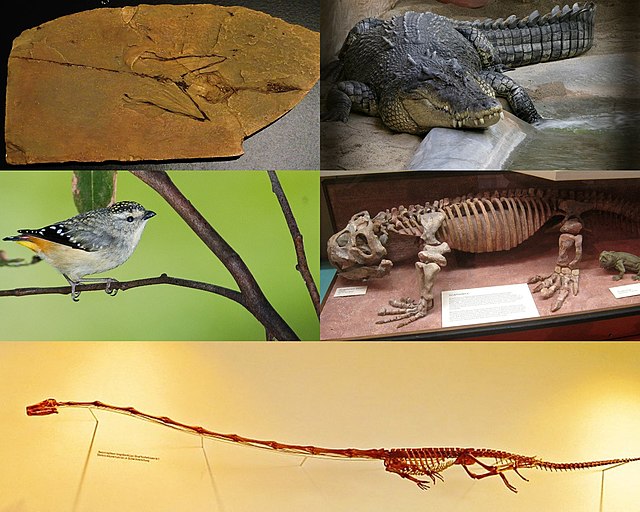Azendohsaurus is an extinct genus of herbivorous archosauromorph reptile from roughly the late Middle to early Late Triassic Period of Morocco and Madagascar. The type species, Azendohsaurus laaroussii, was described and named by Jean-Michel Dutuit in 1972 based on partial jaw fragments and some teeth from Morocco. A second species from Madagascar, A. madagaskarensis, was first described in 2010 by John J. Flynn and colleagues from a multitude of specimens representing almost the entire skeleton. The generic name "Azendoh lizard" is for the village of Azendoh, a local village near where it was first discovered in the Atlas Mountains. It was a bulky quadruped that unlike other early archosauromorphs had a relatively short tail and robust limbs that were held in an odd mix of sprawled hind limbs and raised forelimbs. It had a long neck and a proportionately small head with remarkably sauropod-like jaws and teeth.
Illustration of a partial A. laaroussii jaw bone with teeth
Life restoration of Shringasaurus, a closely related azendohsaurid
Life illustration of the Moroccan dicynodont Moghreberia
Image: Saturnalia NT small
Archosauromorpha is a clade of diapsid reptiles containing all reptiles more closely related to archosaurs rather than lepidosaurs. Archosauromorphs first appeared during the late Middle Permian or Late Permian, though they became much more common and diverse during the Triassic period.
Archosauromorpha
An interaction between two archosauromorphs: Ornithosuchus ( a member of Archosauriformes) scavenging on Hyperodapedon (a rhynchosaur)
The skeleton of Protorosaurus, one of the oldest archosauromorphs and namesake of the problematic group "Protorosauria"
Champsosaurus, a gharial-like choristodere which survived the Cretaceous-Paleocene extinction event. Choristoderes may represent the fifth group of archosauromorphs, but their origin is obscured.








